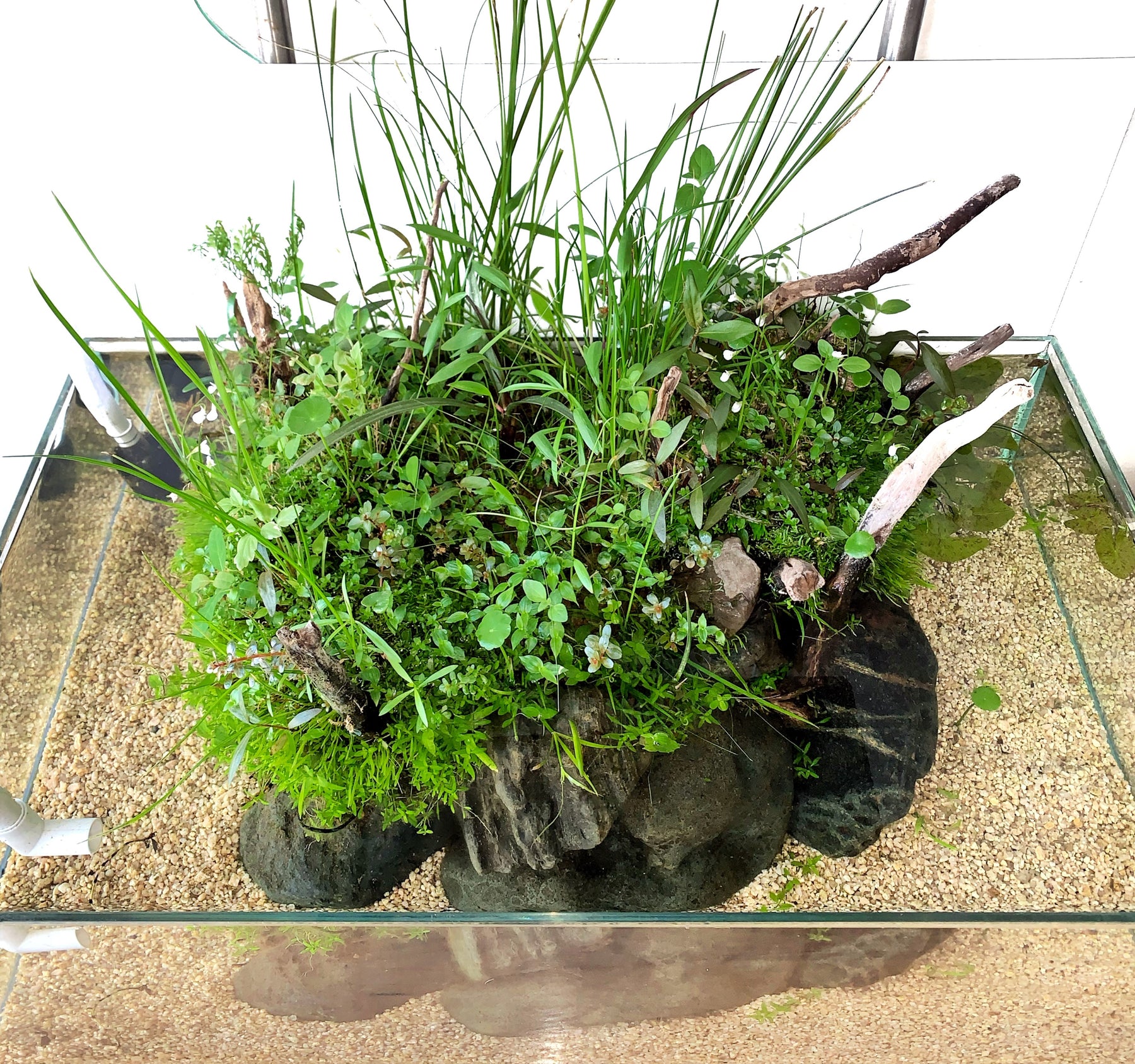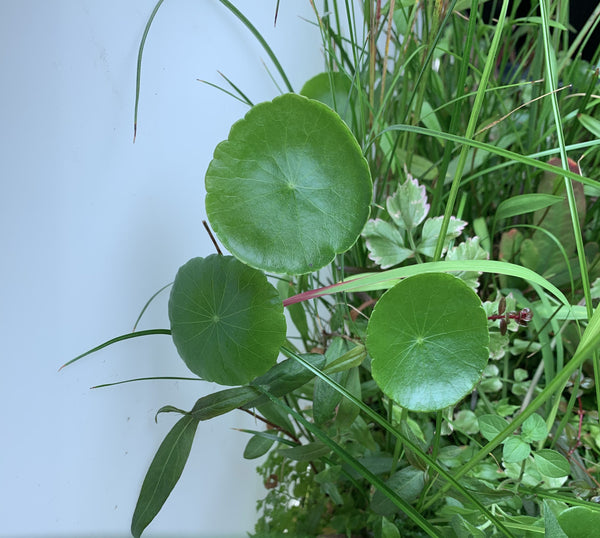
Heterandria Formosa Habitat Aquascape
Written By: Chris (@shrimpery)
Heterandria formosa is the smallest live bearing fish and one of the world’s smallest vertebrates in general. Native to shallow planted areas at the water’s edge, they are a perfect fit for my pond-style aquascapes. Membership in the Poeciliidae family makes the species a relative of guppies and mollies, although much less commonly kept.
The fish also happens to be native to the area where I grew up, the extreme southeastern part of Alabama (as well parts of Georgia, Louisiana, South Carolina, and Florida) in the southeastern United States. Prolific, hardy, and tiny, I have always wanted to keep them as pets, but have been too distracted by my Japanese rice fish obsession.

Before I even got my hands wet, I laid out some ground rules for my shallow UNS 60S Heterandria formosa habitat planted aquarium. There is often something surprisingly freeing about working within predetermined boundaries; this is part of the reason why we have different styles of aquascapes in this hobby.
Iwagumi, Dutch, nature aquarium, biotopes: each of these styles has a specific set of guidelines that can be loosely adopted or followed to the letter, depending on your inclination and desired outcome. It is possible to succeed without any such framework, but I have noticed that the outcome is often less chaotic if you have some sort of playbook to stick with.
While there are no real guidelines for how to scape a pond tank, I have always had a tendency towards excess planting, perhaps to the detriment of negative space. A judicious use of negative space in an aquascape is often the difference between a tangled mess with no room for the fish to swim and a visually interesting environment that is comfortable for livestock.

For this tank, I set some boundaries, literally, using a circle of beautiful Hakkai stones and driftwood to hold a central island of UNS Controsoil in place. This way, the emergent plants are stopped from spreading outward beyond the margins of their planting zone, leaving plenty of space at the sides of the tank for visual interest and for fish to swim.

Although not a true biotope, I tried to heavily incorporate aquatic plants native to the areas where Heterandria formosa can be found. Most prominently, Hypericum walteri, a shrub-like marginal plant with a branching habit, red stems, and large, bright green leaves is complemented by Rhynchospora colorata, a hardy sedge with long-lasting white flowers that lend the plant its common name, “starrush whitetop.” These are planted among a base of both submerged and emergent forms of Hemianthus micranthemoides, a tiny commonly used aquarium plant that has apparently become largely extinct in its native ranges in North America (I’m not sure how this is possible considering how much of a weed it is in my tanks).
I also planted the central island with some plants not native to North America, including the very colorful and aggressive Imperata cylindrica (Japanese blood grass); umbrella-like Hydrocotyle verticillata; pink-and-white variegated Oenanthe javanica (water celery); the enigmatic stem-like true grass Sphaerocaryum malaccense, Polygonum ‘Sao Paulo;’ as well as Baldellia ranunculoides (lesser water plantain), which produces countless tiny pink flowers that only last a day or so.
Of note, I do not spray or mist any of the emergent plants, and the room is not very humid, either. The plants in this tank are mostly temperate or subtropical species that can adapt to the environment of the interior of a typical Western home, and do not need any extra care in terms of humidity or heating. In fact, intermittent misting (while very helpful for many tender tropical plants) does little for the plants I chose for this tank and may even cause health issues for Sphaerocaryum and Hypericum, which have tiny hair-like structures on their emersed leaves that repel even the smallest droplet of water.
Underwater, I relied on spillover from the plants above, Utricularia graminifolia, and a single tiny Helvola dwarf water lily. Surrounding the central island, I used light-colored, larger-grained natural sand for a minimalist look. Eventually, however, I got a bit bored with the sand and replaced it with a lighter colored UNS Controsoil. I sparsely planted the aquasoil with Micranthemum “Monte Carlo” and Marsilea crenata, two aquatic plants that are great at tolerating the low tech (non-CO2) conditions of my tank.
As usual, I utilized a UNS Titan LED light fixture, which I hung well above the water’s surface using a UNS light hanging kit. The extremely powerful light had no problem illuminating the entire tank, including the plants below the surface. I also used a UNS canister filter, with stainless steel inflow and outflow piping on opposite ends of the tank (I used an inflow pipe as outflow to help mitigate the strong current from the filter, as the Heterandria Formosa prefer good water turnover with little flow).
Besides these two pieces of equipment, there is no other tech involved; as autumn approaches and the weather cools, I will either relocate the tank to my basement or add an in-line heater (the room that this tank is in gets quite chilly in the winter; otherwise, I would rely on my home heating system to maintain room temperature and forgo a heater). The freshwater fish have adapted very well to their new home and are rapidly breeding.

It is extremely difficult to perform my biweekly 40% water changes (using RODI water remineralized with Saltyshrimp Gh/KH+) without siphoning up at least one or two tiny fry. There are no other fish species in the tank, but the Heterandria formosa do share their environment with red Neocaridina shrimp. I am considering adding some Japanese rice fish (Oryziaslatipes) to the tank as well, but am concerned that they will harass the smaller Heterandria formosa. The tank will likely remain (nearly) a one-species-tank, at least for the time being.
This aquascape is a great example of how a tank can move in unexpected new directions while still retaining its essential character. I had intended the Sphaerocaryum to form a dense bush which would be the centerpiece of the tank, but instead, the Hypericum walteri and the Hemianthus micranthemoides wound up dominating the tank visually. The Baldellia ranunculoides wound up “infiltrating” the other plants with many random tall leaves or flower stalks intermittently sticking up from the mass of other plants, as opposed to forming discrete groupings like I am used to with some of the grass-like plants I have utilized in the past.

As winter approaches, I am increasingly interested in adding pressured carbon dioxide (CO2) to the tank, to add interest to the underwater portion when the emergent plants begin to succumb to the cold. Setting up a new tank is one of the most exciting parts of aquascaping, but there is something even more satisfying about watching a scape evolve over time.
Tell us - Was this article helpful? Please leave a comment below!
If you have any questions regarding this article, please DM us on Instagram, Facebook, or email support@buceplant.com so we can assist you - @buceplant







Comments
Leave a comment